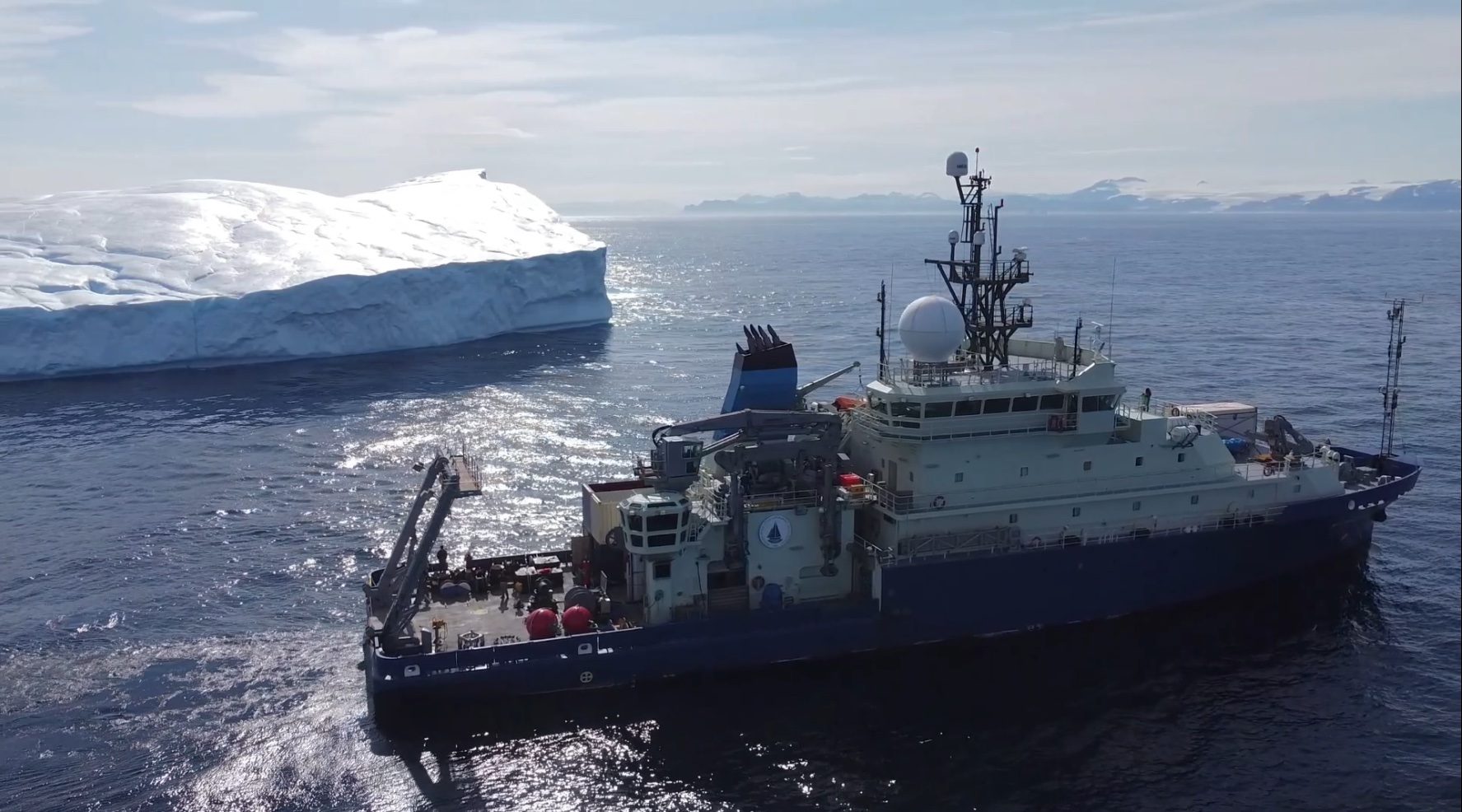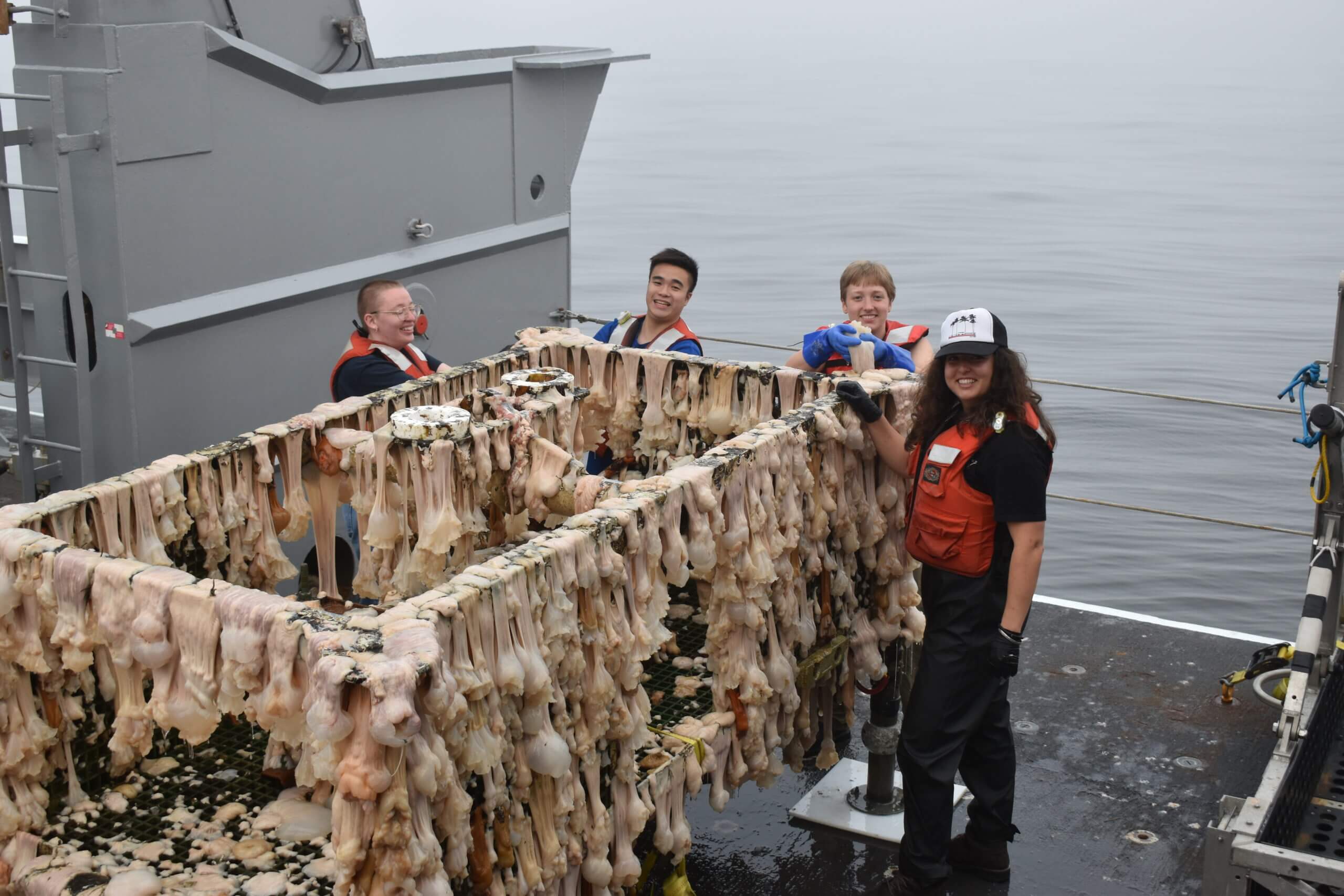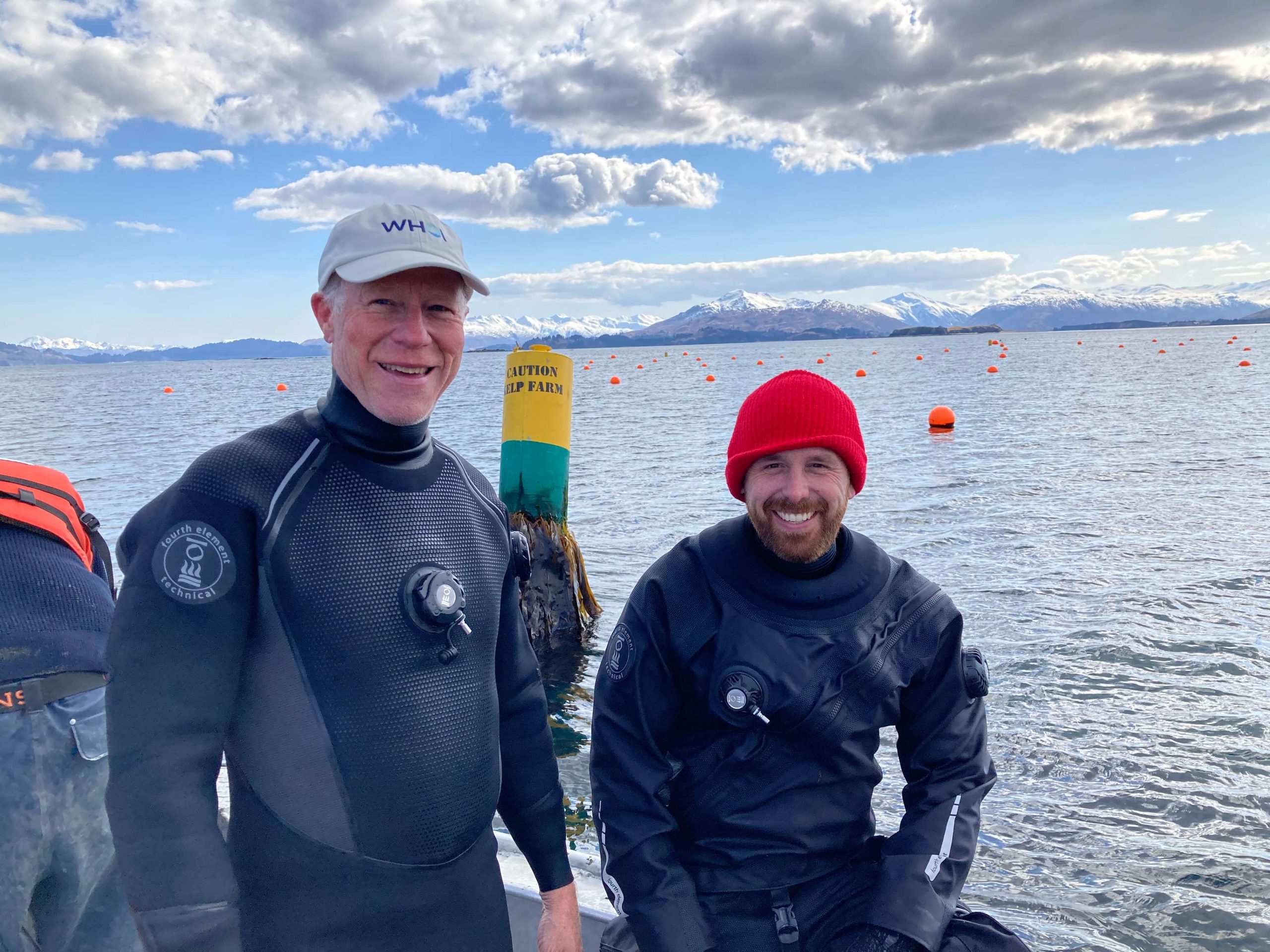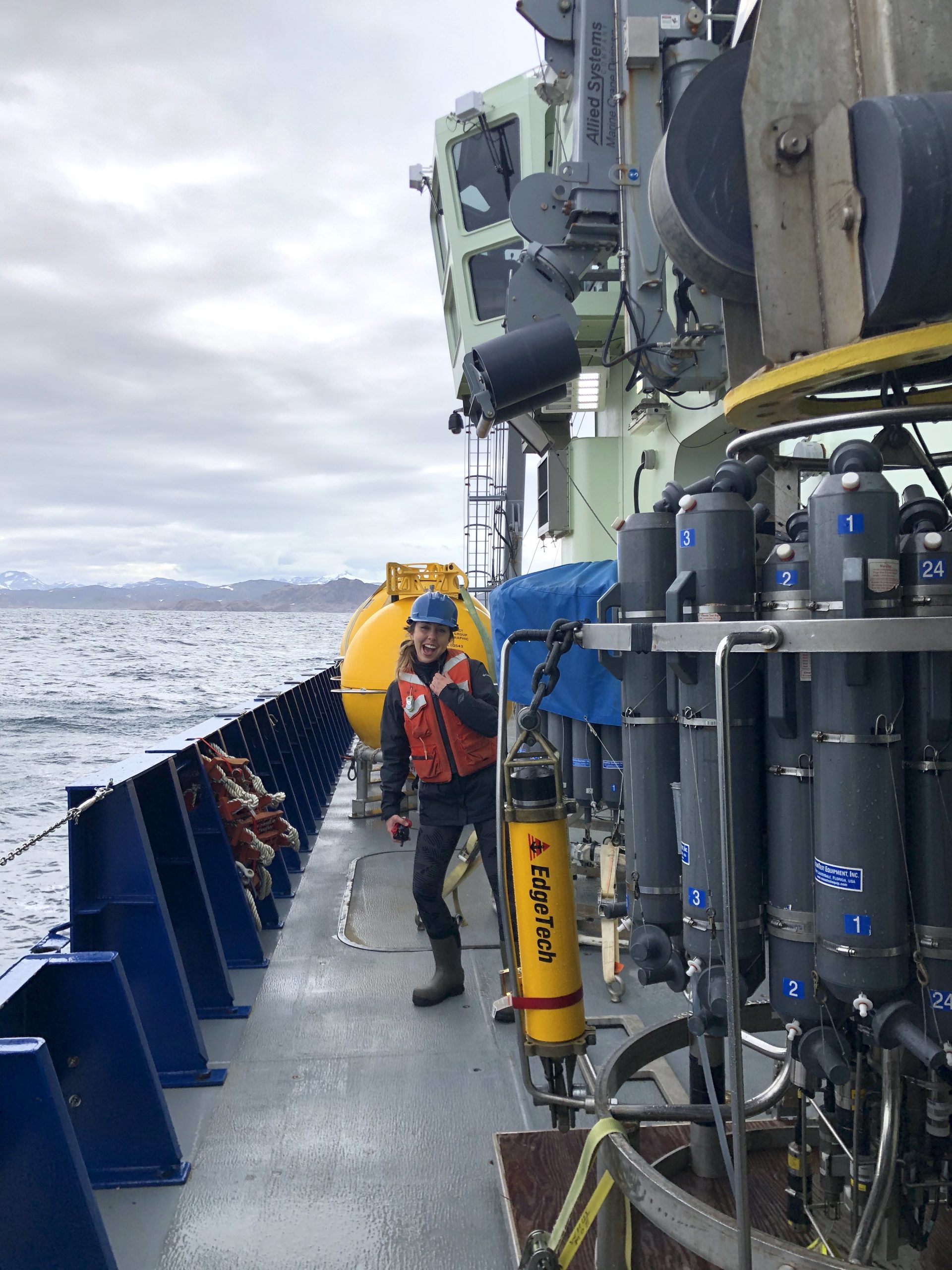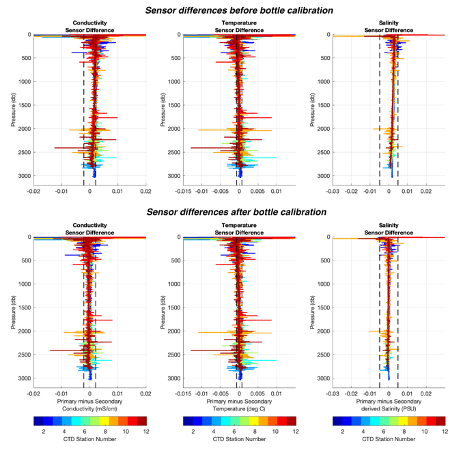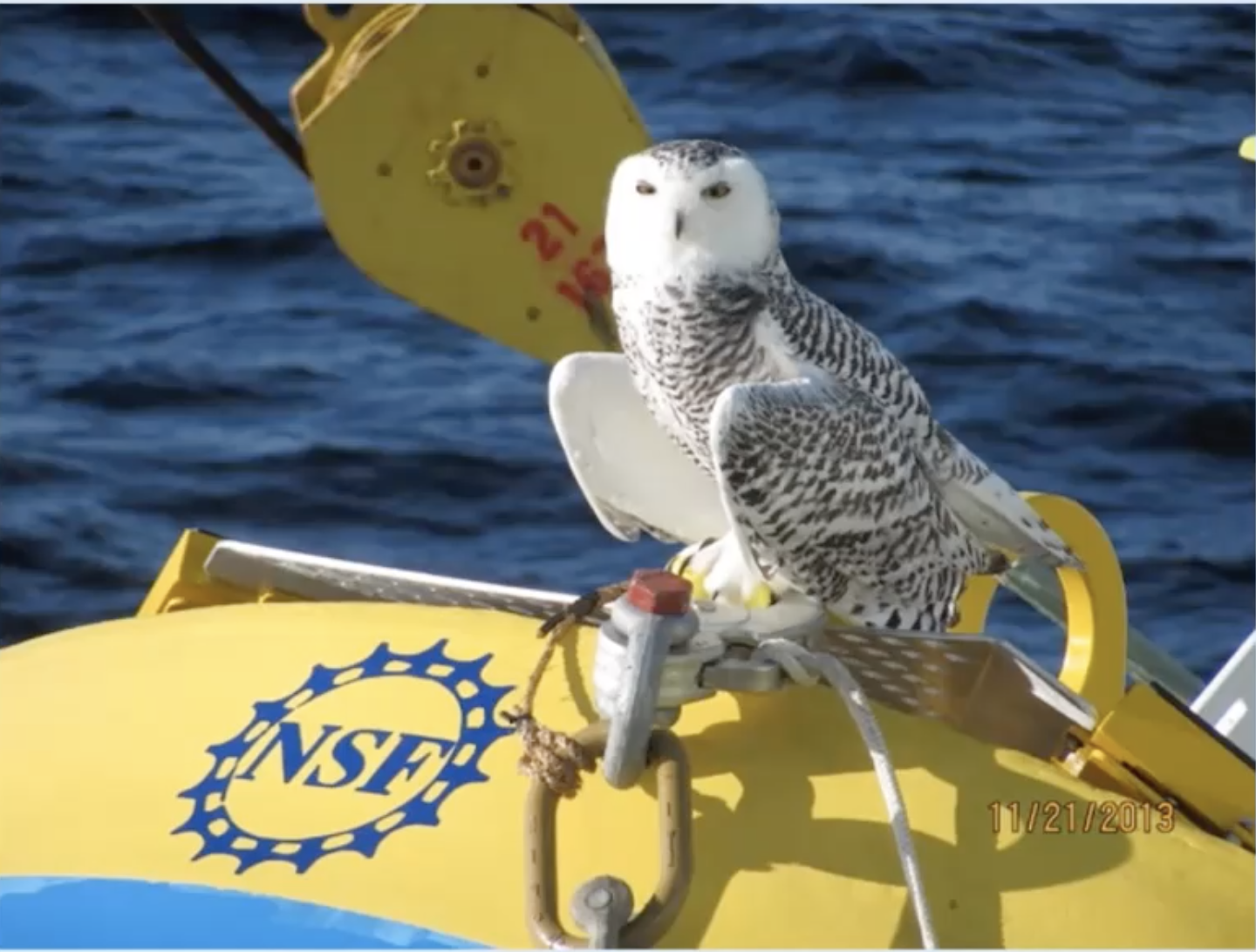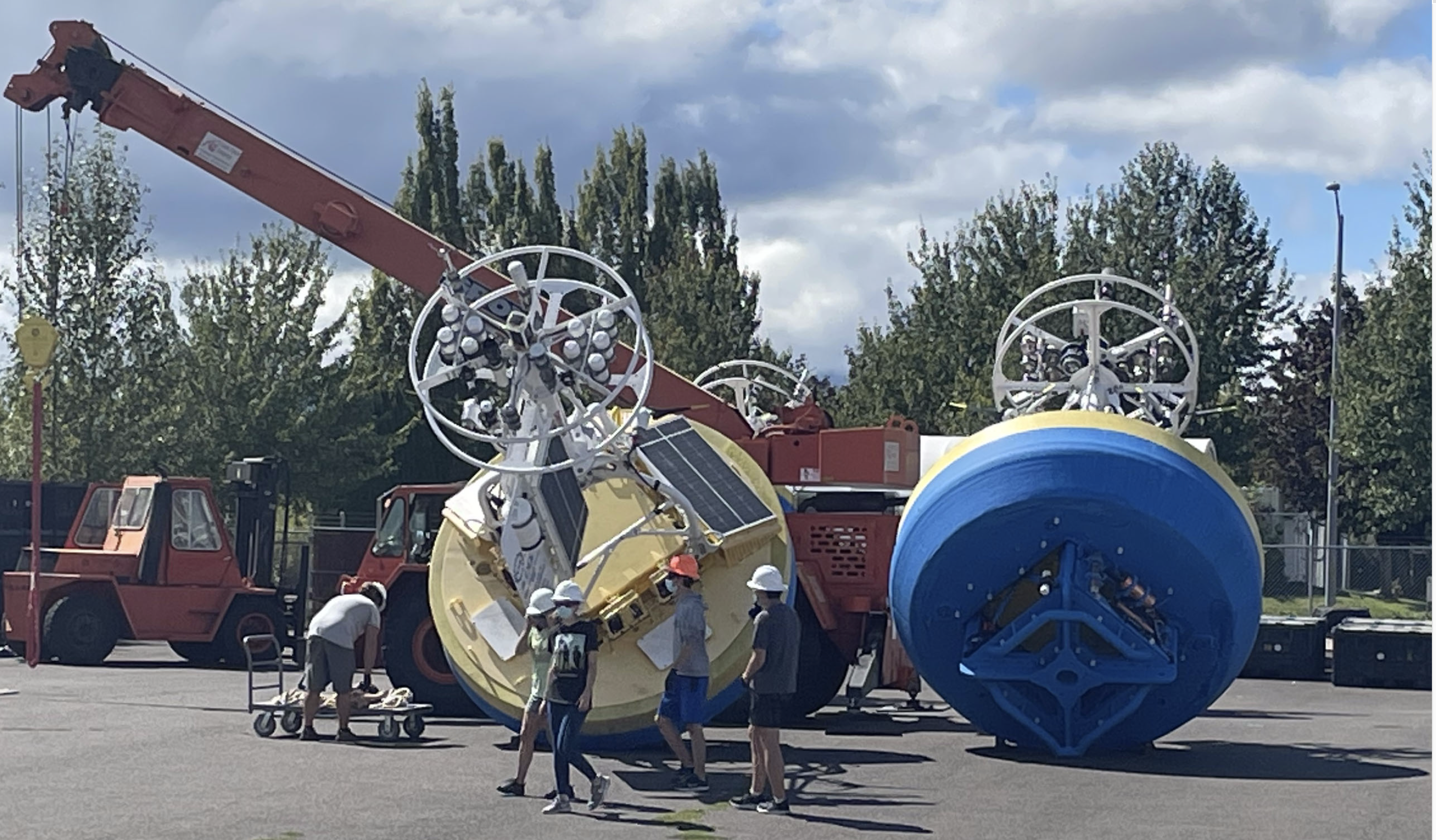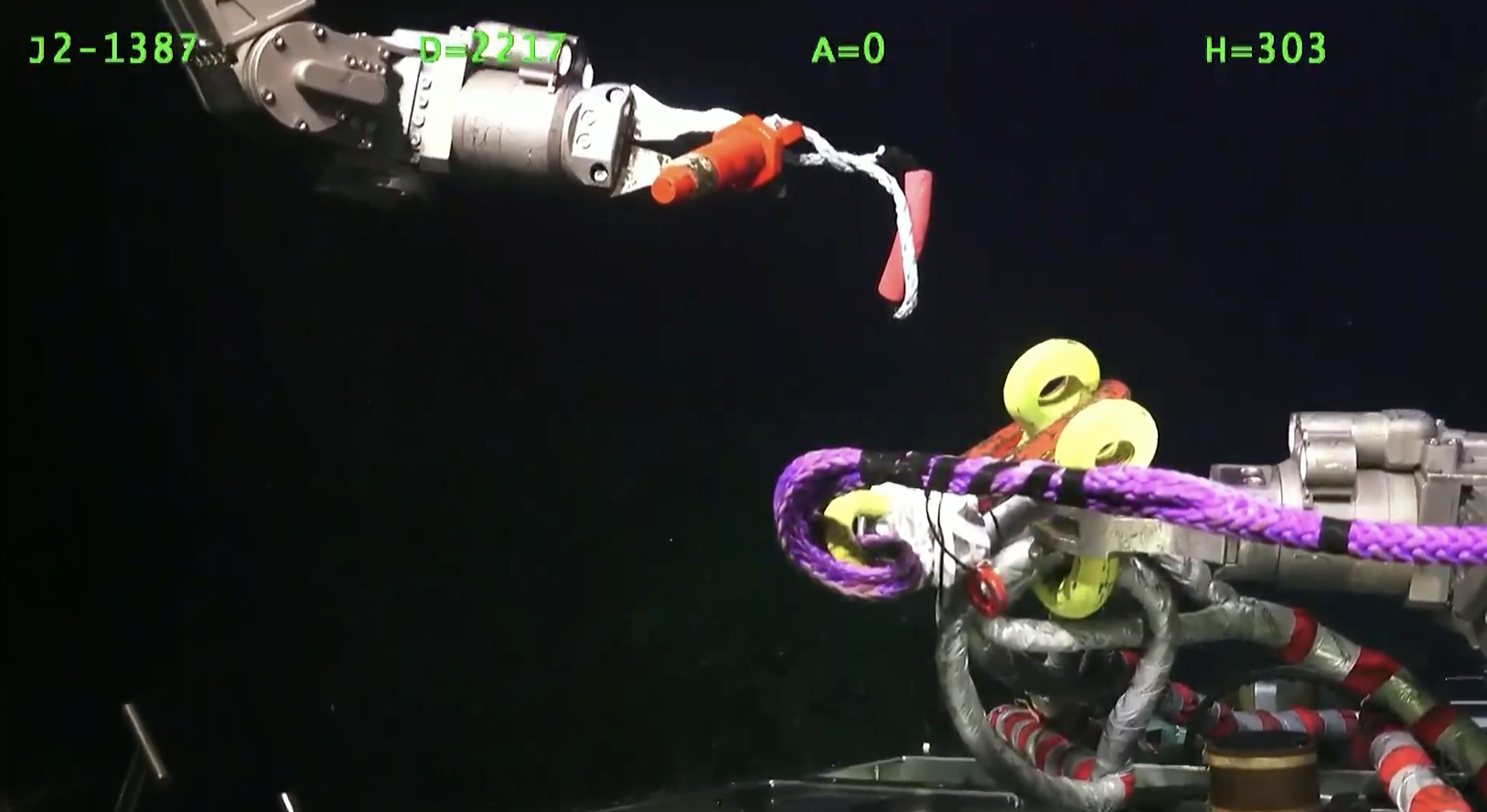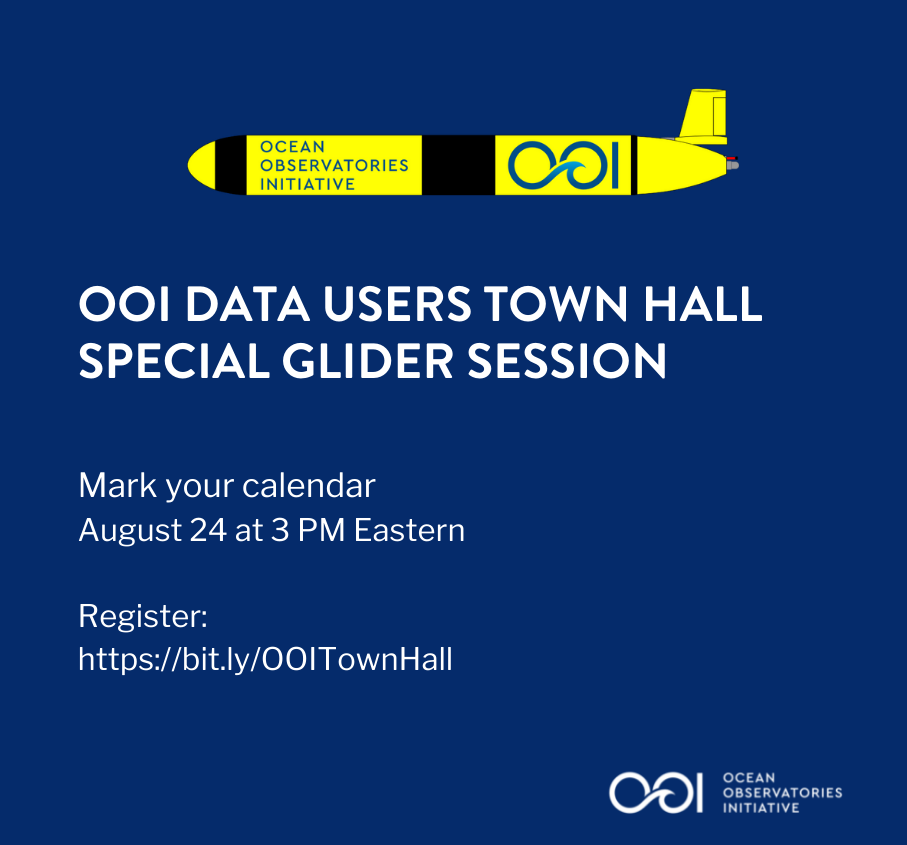News
Irminger Array Successfully Turned 8th Time
The Irminger 8 Team successfully wrapped up the eighth turn of the Global Irminger Sea Array on 26 August when the R/V Neil Armstrong docked in Reykjavik, Iceland. After a few days of demobilization, the 10 members of the science party were free to head home after showing proof of a negative COVID test 72 hours before boarding a flight back to the U.S.
Chief Scientist John Lund led the science party of 10 in completing all of the expedition’s objectives. Over the course of 26 days at sea, they recovered four moorings and deployed four new moorings in their place. The team also deployed three gliders—two Open Ocean and one Profiling—and recovered a glider that had been in the water since 2020 and whose battery supply was rapidly depleting.
[media-caption path=”https://oceanobservatories.org/wp-content/uploads/2021/08/Armstrong-and-Iceberg-e1629493552453.jpg” link=”#”]The Irminger Sea presents challenges of high winds, strong waves, and icebergs as shown here with the R/V Neil Armstrong in the foreground. Credit: drone video, Croy Carlin SSSG. [/media-caption]One highlight of the trip was engaging in scientific outreach with a class of fourth graders. The team connected with the students while out on the open ocean via Zoom. The oceanographers aboard the ship each had a chance to share what it’s like being on an oceanographic voyage and explain the purpose of the different instruments and sensors on the arrays. Another highlight of the expedition was the OOI team’s ongoing collaboration with OSNAP (Overturning in the Subpolar North Atlantic Program). While OSNAP participants were not onboard the Armstrong as in the past, their shore-based presence was clearly in evidence. Expert hydrographer Leah McRaven worked with the onboard team to adjust CTD (Conductivity, temperature, depth) sampling to ensure that new CTD equipment was calibrated and sampling properly.
The science team also added a novel twist to the regular shipboard sampling that supports field calibration and validation of the platforms and sensors in the arrays. During Irminger 8, the shipboard team worked with OOI’s onshore data team to make collected CTD data available online in near real-time. As an added bonus, McRaven shared her insights about CTD sampling in regular blog posts here.
The Irminger 8 Team took full advantage of being in this critical ocean region, which is sensitive to climate change. During transit from Woods Hole to the array, off the southeast coast of Greenland, the team deployed surface drifters and ARGO floats for the Greenland Freshwater Project, which is studying the impact of freshwater runoff from Greenland’s melting ice sheet on the North Atlantic and Arctic climate. The team also deployed a biogeochemical ARGO float for the Global Ocean Biogeochemistry Project, and took a series of CTD casts on behalf of OSNAP, to add to long term data collection efforts in this critical region. In addition, the team deployed two RAFOS floats for the Madagascar Basin Project to measure deep water circulation and 15 Sofar Spotter buoys to measure wind, wave, and temperature data.
“In the ideal, science is a collaborative process,” said Chief Scientist John Lund. “During transit time to and from the array, we were able to help our scientific partners get their equipment in the water. The data provided will help advance understanding of this critically important region, which is equally difficult to sample. The region has high winds, large, steep waves, strong currents, icebergs, and consequent equipment icing.”
Given the challenges of the ocean environment at these latitudes, the eighth turn of Irminger Array included equipment improvements. The newly deployed surface moorings included wind turbine modifications to help it withstand strong, volatile winds, and it also incorporated other structural modifications to strengthen the mooring, while easing refurbishment. Similarly, design modifications were made to the subsurface moorings to help ensure consistent, long-term data collection.
The team experienced some of these challenges of high winds and strong waves while on the cruise, but the rough conditions were compensated by the gorgeous scenery of the region. Added Lund, “One afternoon, the sun came out as the ship transited further up Prince Christian Sound. Everyone was awed by the beauty of the landscape. We saw glaciers, icebergs and the occasional whale.”
Prior to leaving the Sound, the team secured all the items for the transit to Reykjavik, the demobilization of the ship, and finally the journey home to Woods Hole.
Read More
37-day RCA Cruise Met All Objectives and More
This summers’ Regional Cabled Array (RCA) 37-day expedition was one of the most complex of the seven annual Operations and Maintenance cruises to date. Not only was the expedition impacted by COVID restrictions, but it also included four Legs, a full contingent of engineers, scientists, students, and the Jason team, as well as coordinated ship operations with the R/V Thompson, the IT Integrity cable support ship, and the Ocean Exploration Trust ship the E/V Nautilus. However, thanks to the hard work of the RCA staff, and amazing support from the R/V Thompson (Captain Dave Vander Hoek) and ROV Jason teams, (Expedition Leads Ben Tradd and Mario Fernandez) the expedition was highly successful with the completion of all scheduled tasks…and more.
The expedition was led by Chief Scientists Mike Vardaro (Leg 1) and Orest Kawka (Legs 2-4), and Co-Chief Scientists James Tilley (Legs 1-3), Wendi Ruef (Leg 1 – this was the first time Ruef has sailed as a Co-Chief Scientist), Mike Vardaro (Leg 2), and Katie Bigham (Leg 4). Katie will receive her Ph.D. in 2022 from the University of Wellington, NZ. This cruise provided her a strong early career foundation for becoming a future Chief Scientist. James Tilley was the lead engineer and Larry Nielson led shore support.
COVID safety protocols significantly increased cruise complexities, which included the verification of full COVID vaccination status for all ship and science party members, ensuring that all participants sheltered-in-place, and the arrangement of COVID tests spanning both Washington and Oregon testing sites. The RCA team is highly appreciative of the exceptional support that the UW Marine Operations group provided to ensure our safety, the dynamics of crew changes, and modification of dock-side logistics in response to IT Integrity and E/V Nautilus operations.
[media-caption path=”https://oceanobservatories.org/wp-content/uploads/2021/09/PD01A_20210821_084428_recovery-scaled-1.jpeg” link=”#”]The Slope Base Deep Profiler Mooring comes aboard the R/V Thompson. Credit: M. Elend, University of Washington, V21. [/media-caption]Highlights: During the four Legs, just over 200 RCA Core and PI instruments were recovered/deployed, the Platform Interface Assemblies and Science pods on all three Shallow Profiler Moorings were turned, Deep Profiler vehicles were turned at the Oregon Offshore and Axial Base sites, and the Deep Profiler mooring was turned at Slope Base. Of particular note, the southern cable line was repaired, resulting in the return of full operational status for Primary Nodes PN1C and PN1D, providing communications and data flow once again to/from the Oregon Offshore and Shelf sites.
Over the 37 days of staging, mobilization, and demobilization for the four Legs, twenty 48 ft trailers transported 394,000 pounds of RCA equipment to and from Seattle, WA and Newport, OR. Onboard staffing included twenty-one RCA scientists and engineers, 13 ROV Jason crew, 16 students, 1 postdoc, and an artist, as well as two research scientists. During the 30 at-sea days, including two to aid in the recovery of the Ocean Exploration Trust ROV Hercules and Argus vehicle from the Endeavour Segment of the Juan de Fuca Ridge, the R/V Thompson transited ~1775 miles, 49 Jason dives were completed traversing a total of~ 125,000 meters of the water column, seven CTD casts with water sampling were completed spanning maximum cast depths of 200 m to ~ 2900 m, and two EM302 bubble plume surveys were conducted over methane seep sites at Southern Hydrate Ridge and Pythias Oasis. Finally, a new, highly active methane seep area was discovered east of the novel Pythias Oasis vent site, which has been continuously venting since its discovery in 2014.
PN1B: During Legs 1 and 2, significant and dynamic coordination was required to ensure that the R/V Thompson and C/S Integrity operations (lead by APL Engineer Chuck McGuire) were tightly coupled and that shore cranes and trucks were in place for mobilization and demobilization of both the RCA cruise gear and that associated with the recovery-repair of Primary Node PN1B. Three dives (August 5: J2-1342, and August 10-11: J2- 1342, and J2-1354) were dedicated to disconnection of cables, preparation of PN1B for recovery, and recovery of a ½ frame deployed by the Integrity, which was utilized for installation of the recovery line. The R/V Thompson-ROV Jason operations went well. Although the replacement PN1B installation could not be completed, the cable Segments 2-3 were joined and then successfully installed on August 23 – reinstating power and communications to Primary Nodes PN1C and PN1D. Unfortunately, the Southern Hydrate Ridge site will remain offline until next year, when PN1B can be reinstalled. However, joining of the segments allowed 76% of the instruments to go live again that had been offline since August 2020, as well as the Shallow Profiler and Deep Profiler moorings and BEP at the Oregon Offshore site, and the BEP and other seafloor instruments at the Oregon Shelf site.
VISIONS’21: Once again, live streaming of video and updates on the cruise were provided on the interactiveoceans website as part of the UW- RCA VISIONS’21 engagement efforts and highlights were provided on Instagram and Twitter. The 16 undergraduates that participated on the cruise worked four-hour shifts in the ROV control van, they learned how to process and analyze CTD samples, and they helped with cleaning of recovered RCA equipment (a big hit). Their enthusiasm permeated the team and their hard work contributed significantly to the cruise. We were grateful to have a resident watercolor artist onboard who shared aspects of the cruise and seafloor and biological observations through her eyes. The students shared their experiences through blogs and for many it changed their lives – a few examples of their impressions:
I found this to be a once in a lifetime opportunity and [it] offered me a broader perspective of how much preparation and consideration goes into the planning and execution of the research projects being facilitated through the OOI VISION’s expedition. It opened my eyes to the full circle of science.
This has truly been one of the coolest experiences I’ve had …. after 4 quarters of zoom classes and online labs, I’ve been so happy to finally get a feel for oceanographic research out in the field and to work with the instruments I’ve been learning about for a year and a half.
As a kid, I watched documentaries about the deep sea and imagined myself descending into the depths with the camera, sometimes sitting in a cardboard box “submarine” that I made. Being here and getting to work in the Jason van feels like accomplishing some part of that dream, and I’m very grateful to have had the opportunity to come on this trip. I’ve also come away with a better idea of how data are collected at sea, and in speaking with the scientists onboard I’ve gained a better understanding of how one goes about getting into the field.
Externally Funded Projects: The 2021 program was also another successful field season for turning, and installation, and recovery of instrumentation, and for science programs funded outside of OOI. This work included:
- The turning of NSF-funded CTDs at the ASHES hydrothermal field and at the Eastern Caldera sites, as well as installation of a new CTD at Central Caldera at the summit of Axial Seamount (W. Chadwick, Oregon State University – OCE 1928282 “Phase 2 of Enhancements to the OOI Cabled Array at Axial Seamount”). [1-day]
- The reinstallation of the University of Bremen-Germany-funded cabled overview multibeam sonar for imaging of all methane plumes at Southern Hydrate Ridge (G. Bohrmann and Y. Marcon -University of Bremen – Sonar monitoring of natural release of methane greenhouse gas from the seafloor – A contribution to the understanding of global change), the 4K camera, and turning of a CTD. [1-day]
- Installation of an NSF-funded new Pinnacle ADCP at the Central Caldera site to provide, for the first real-time, monitoring of currents throughout the entire ~1500 m water column (D. Manalang and D. Kelley, University of Washington – OCE 2129943 “RAPID: OOI-Industry Partnership to Install a Cabled 45 kHz ADCP at Axial Seamount Caldera”). This effort is in partnership with Teledyne Marine.
- Recovery of a NSF-funded self-calibrating pressure sensor at the geodetic-focused Central Caldera site (William Wilcock, University of Washington – OCE 1634103 – “A Rotating Tiltmeter for Marine Geodesy: Development and Testing at Axial Seamount on the Ocean Observatories Initiative Cabled Array”).
- A NSF-funded dive to complete site characterization, based on an ~ 1 m resolution bathymetry Sentry map, of the Pythias Oasis ridge. The dive focused on a “gully” that runs parallel to the ridge and s significant depression at the termination of the ridge (D. Kelley, University of Washington – OCE 1658201 “Collaborative Research: Pythia’s Oasis – Access to Deep Subduction Zone Fluids”). Pythias Oasis is venting fluids unlike any yet discovered in the world’s oceans. They are likely sourced at/near the plate boundary. Evidence of additional sites of seepage were discovered. [1-day]
- Three dives funded by the Bureau of Ocean Energy Management (D. Kelley, University of Washington – M21AC00009-00 “Arctic Marine Mineral Exploration – Ramen Laser Spectroscopy Validation”) at the ASHES hydrothermal field in support of the NASA InVADER program. Major and gas-tight vent fluids and several sulfide samples were recovered, and a couple microbial incubation experiments were deployed [1-day].
Recovery of the ROV Hercules and Argus Vehicle: On August 26th, the Ocean Exploration Trust ROVs Hercules and Argus became detached from the tether on the E/V Nautilus working east of the Main Endeavour Field (MEF) on the Endeavour Segment of the Juan de Fuca Ridge (2220 m). After a flurry of phone calls and Zoom meetings, the R/V Thompson, RCA, and OET (Expedition Lead Allison Fundis) teams came together for a community effort to recover the vehicles. The R/V Thompson transited ~ 10 hrs north to the MEF where there were two Jason dives to facilitate the September 2 successful recovery of the vehicles back onboard the E/V Nautilus. The effort required extension of the RCA cruise by two days, and it was a weary team that pulled back into Newport on September 3. Demobilization was complete on September 4th.
Read More
Seaweed May Be a Solution to Faster Climate Mitigation
Scott Lindell wants to explore the potential to sequester carbon dioxide and help mitigate the climate crisis by growing seaweed and sinking it to the bottom of the Atlantic Ocean.
Lindell, a researcher at Woods Hole Oceanographic Institution, studies how marine aquaculture can be used for sustainable production of food and fuel. He started his scientific career studying fish farming, and “I’ve been working my way down the food chain ever since,” he says. With funding from the Department of Energy, Lindell’s team has already developed breeds of sugar kelp that yield four times the biomass of typical commercial production.
[media-caption path=”https://oceanobservatories.org/wp-content/uploads/2021/09/Scott-and-Dave-diving-in-Kodiak-1-scaled.jpg” link=”#”]Scott Lindell (l) and David Bailey post-dive on their demonstration kelp farm in Kodiak, AK. Credit: Domenic Manganelli[/media-caption]Seaweeds, like trees, uptake carbon dioxide and convert it into biomass. Oceanographic models predict that if humans sink that seaweed biomass to depths of 1000m or greater, then depending on microbial activity and dissolved oxygen in the water, it may take years or even decades for that carbon to break down. And, because the seaweed would be submerged at great depths, it would take centuries for that carbon to recirculate to surface water and re-equilibrate with the atmosphere.
Seaweed farming, like planting forests, could thus be a natural solution to taking carbon dioxide out of the atmosphere. But compared to planting forests, seaweed farming has the potential to scale up much more rapidly, with the added benefit of not competing for land used for farming crops.
“It would take an area on the order of twice the size of Texas and 40-50 years to create a forest that takes one gigaton of CO2 out of the atmosphere,” says Lindell. “And that forest might only store the carbon for another 40-50 years depending on forest fires, windfall, how fast the trees grow, and other factors.”
But with seaweed farming, Lindell says, “that same one gigaton removal of CO2 could be achieved by an operation as small as the state of Iowa in a year or two’s time, once the farms are developed.”
Lindell and his colleagues have already submitted proposals to study sinking kelp on the U.S. Pacific Coast, where the continental shelf drops off much faster and experiments can be done closer to shore. But he’s also interested in running experiments on the U.S. Atlantic Coast, where commercial farming of sugar kelp (Saccharina latissima) is growing rapidly.
“Our simple demonstration would be to bundle up a ton of seaweed and get it to the deepest parts of the OOI Pioneer Array, about 500 m deep. Then we’d surround it with a benthic lander equipped with cameras and sensors to monitor the rate of degradation and understand the environmental and ecosystem effects,” Lindell explains. He also plans to compare microbial activity and oxygen profile habitability in the sediments around the experimental site with those in sediments from an unimpacted site.
Lindell has started the process of user engagement with the OOI team to find ways to align these experiments with operations at the Pioneer array. “This works better if there’s already some environmental monitoring going on,” he explains. Since most seaweed farming operations on the East Coast are situated in New England waters, the area where Pioneer is currently deployed may be similar to the environments where sequestration efforts might take place.
Lindell believes it’s important to have thorough research on using seaweed as a carbon sequestration method before it becomes a larger operation.
“Iron fertilization has also been considered a climate solution, but early experiments were not carried out very carefully. That was a missed opportunity to learn more about how these solutions could work,” Lindell clarifies. “We want to get ahead of what’s become a building movement and make sure that early efforts are well monitored. We want to do it responsibly.”
Although it will take time to research and develop this carbon sequestration strategy into a commercially scalable operation, Lindell is optimistic about this method’s potential.
“We’ve got to do something,” he says. “I’m excited that this could be a short-term and expedient climate solution.”
Read More
Everything You Need to Know about CTD data
In August 2021, expert hydrographer, Leah McRaven (PO WHOI) from the US OSNAP (Overturning in the Subpolar North Atlantic Program) team, worked with the OOI team members aboard the R/V Neil Armstrong for the eighth turn of the Global Irminger Sea Array to support collection of an optimized hydrographic data product. A truly novel aspect of this collaboration was the near real-time sharing of OOI shipboard CTD data with the public. McRaven also shared her reports while the cruise is underway. In doing so, she provided a detailed explanation of the process of ensuring that CTD profiles are accurate and useable for future research use.
We share her blogs below. For archival purposes, they will also be available on the Community Tools and Datasets page.
BLOGPOST #4 (September 13, 2021)
Another OOI cruise is in the books! Now that things have wrapped up and I’ve had a chance to dig into the data a bit more thoroughly, how did we do? In my previous post I reported that the Irminger 8 CTD data looked to be very promising, but I like to include one more step before recommending data to be used for science: carefully considering salinity bottle data.
Salinity bottle data can be used in many ways to support a particular scientific objective or research question. The two that I’ve become most familiar with are 1) to support the analysis of additional bottle samples (e.g. dissolved oxygen) and 2) to provide an additional assessment and calibration of the CTD conductivity sensors. Both applications are necessary when researchers require salinity values more accurate than what CTD sensors are able to provide. However, even if this is not required, it can help ensure that users receive data that are reasonably within manufacturer specifications.
I find it easiest to consider the GO-SHIP approach to bottle data first. Using ship-based hydrography, GO-SHIP provides approximately decadal resolution of the changes in inventories of heat, freshwater, carbon, oxygen, nutrients, and transient tracers, covering the ocean basins with global measurements of the highest required accuracy to detect these changes. For a program like this, 36 salinity samples are taken every CTD station in order to provide an extremely accurate and precise calibration for the CTD sensors. Interestingly, the Irminger OOI array is bracketed by three GO-SHIP repeat transects. While GO-SHIP provides invaluable measurements, drawing a large number of samples can be expensive and time consuming. Additionally, measurements occur on a decadal timescale, so there is a lot of the picture we miss.
One of the research programs that aims to provide a higher temporal and special resolution picture of the North Atlantic is OSNAP. This program has several scientific objectives, but generally aims to quantify intra-seasonal to interannual variability of the Atlantic Meridional Overturning Circulation(AMOC) in the subpolar Atlantic. This includes a focus on heat and freshwater fluxes, pathways of currents throughout the region, and air-sea interaction, all of which require highly calibrated data products. In order to accomplish this, PIs from the program need to be able to consistently merge their shipboard and moored data products for cohesive and accurate quantification of parameters. Because much of the variability being studied is so large, researchers do not necessarily need salinity accuracies at the level of GO-SHIP, but they do need to use salinity bottle samples to ensure that CTD casts are at the very least within manufacturer specifications.
In the end, no one approach to hydrographic sampling is necessarily better than another. What is important is the delicate balance of resources while at sea that best support the scientific objectives. For both OSNAP and OOI, where the primary work at sea is focused on servicing moorings, the resources for a GO-SHIP approach to sample bottle collection is simply not feasible. However, one very key feature of the OOI CTD data is that they are collected annually, while ONSAP data are collected every two years, and GO-SHIP data are collected every ten years. Hence, OOI is able to fill in some of the temporal data gaps in the region and greatly bolster many of the international programs working in the region.
This year OOI collaborated with numerous PIs and representatives from research programs that operate in the Irminger Sea region to produce a more optimized CTD and bottle sampling strategy that better complements goals similar to GO-SHIP, as well as several additional objectives from international programs, such as OSNAP. The goal of this updated plan was to provide OOI data end users and collaborators with data that are more appropriate for CTD, mooring, glider, and float instrumentation calibration purposes. In particular, the update included increased sampling of the deep ocean. Such data are critical in the Irminger Sea region due to the uniquely large variability of temperature, salinity, and chemical properties throughout the shallow and intermediate depths of the water column. Deeper CTD and bottle data will allow all end users to more carefully reference their scientific findings to more stable water masses and allow for better intercomparison with other available datasets, such as the available GO-SHIP and OSNAP data from the region.
The majority of methods that I use when considering salinity bottle data have been adapted from GO-SHIP and NOAA/PMEL. In particular, many of the cruises I work with, including OOI, often have far fewer bottle samples than recommended by GO-SHIP or PMEL methods. This isn’t necessarily bad, since we don’t need to achieve the same goals as those programs, however, great care in adapting methods does need to be considered (and I encourage you to reach out if this is something you have an interest in). So, with the improved OOI sampling scheme, what are the potential benefits to CTD data quality?
More strategically planned salinity bottle sample collection allows users to:
- Decide if data from primary or secondary sensors are more physically consistent
- Identify times when CTD contamination was not obvious
- Assess manufacturer sensor calibrations
- Potentially provide a post-cruise calibration
In the case of the Irminger 8 cruise, I see that all four uses of salinity bottle data are possible, which will make a lot of collaborators very happy! Starting with Figure 1, we can see a summary of CTD and bottle sample salinity differences as a function of pressure for both the primary and secondary sensors. As a rule of thumb, the average offset of these differences can be considered an estimate of sensor accuracy, and the spread, or standard deviation, can be considered an estimate of sensor precision. While the data have a fairly large spread to the eye, the standard deviations (indicated by the dashed lines) are placing the spread for each sensor within what we expect from the manufacturer precision. The striking result from this figure is that before using the bottle data to further calibrate the data, we see that the primary sensor had a higher accuracy than the secondary sensor. In going back to the Seabird Electronics calibration reports for the primary and secondary sensors (available via the OOI website), I noted that the calibrations for each sensor was a bit older than what we normally work with (last performed in May 2019). Additionally, the secondary sensor had a larger correction at its time of manufacturer calibration than the primary. This is corroborated by the differing sensor accuracies as determined by the bottle data. Lastly, while there are a few spurious differences shown, on average there doesn’t look to be any CTD and bottle differences due to factors other than expected calibration drifts.
Figure 1
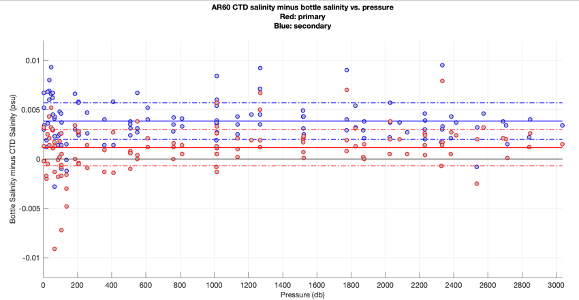
In order to apply a calibration based on the bottle data to the CTD data, I first QC’d the bottle data and then followed methods described in the GO-SHIP manual. There are several sources of error that can contribute to incorrect salinity bottle values, ranging from poor sample collection technique to an accidental salt crystal dropping into a sample just before being run on a salinometer. This is why all methods of CTD calibration using bottle data stress the importance of using many bottle values in a statistical grouping. However, sometimes there are “fly-away” values that are so far gone they don’t contribute meaningful information to the statistics, and in those cases I simply disregard those values. As a reference, for the Irminger 8 cruise I threw out 9 of the ~125 salinity samples collected before proceeding with calibration methods. Note that within the methods described in the above documentation, systematics approaches are used to further control for outlier or “bad” bottle values.
Figure 2
Since the majority of CTD stations for OOI are performed close to one another (and consequently in similar water masses), I grouped all stations together to characterize sensor errors. The resulting fits produced primary and secondary sensor calibrations that allow for more meaningful comparison of data with other programs. Figure 2 shows how primary and secondary data compare before and after bottle calibrations have been applied. Post calibration, primary and secondary sensors now agree more closely in terms of their differences. Similarly, Figure 3 summarizes data before and after calibration in temperature-salinity space, providing visual context for the magnitude of bottle calibration. Many folks working with CTD data would say that this is a rather small adjustment!
Figure 3
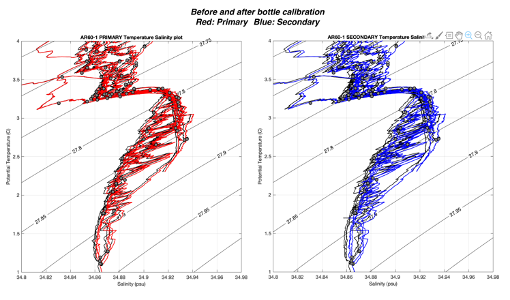
Figure 4
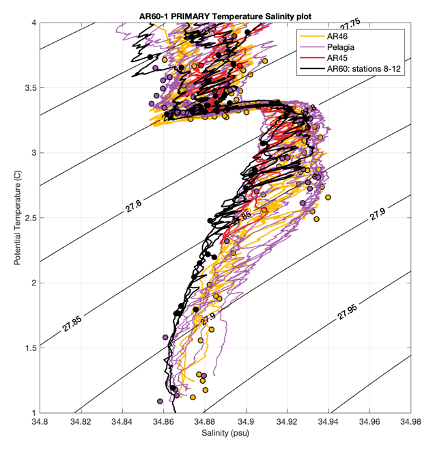 However, Figure 4 shows a comparison of the bottle-calibrated OOI data with nearby OSNAP CTD profiles from 2020. The results here are extremely important as OSNAP currently has moorings deployed near the OOI array and the OOI CTD profiles provide a midway calibration point for the moored instrumentation that is currently deployed for two years. These midway calibration CTD casts are critical in providing information on moored sensor drift and biofouling in a region where there has been a slow freshening of deep water (colder than 2.5 ºC) throughout the duration of these programs. Quantifying the rate of freshening is one of the objectives that OSNAP focuses on, but it is nearly impossible without high-quality CTD data for comparison. Figure 4 demonstrates that the freshening trend has continued from 200 to 2021 and that the bottle-calibrated OOI CTD data will be critical for interpretation of moored data.
However, Figure 4 shows a comparison of the bottle-calibrated OOI data with nearby OSNAP CTD profiles from 2020. The results here are extremely important as OSNAP currently has moorings deployed near the OOI array and the OOI CTD profiles provide a midway calibration point for the moored instrumentation that is currently deployed for two years. These midway calibration CTD casts are critical in providing information on moored sensor drift and biofouling in a region where there has been a slow freshening of deep water (colder than 2.5 ºC) throughout the duration of these programs. Quantifying the rate of freshening is one of the objectives that OSNAP focuses on, but it is nearly impossible without high-quality CTD data for comparison. Figure 4 demonstrates that the freshening trend has continued from 200 to 2021 and that the bottle-calibrated OOI CTD data will be critical for interpretation of moored data.
Finally, for those interested in the salinity-calibrated CTD dataset, please be in touch (lmcraven@whoi.edu). A more detailed summary of the calibration applied can be found in my CTD calibration report here.
BLOGPOST #3 (August 18, 2021)
Irminger 8 science operations are now fully underway, which means the stream of CTD data is coming in hot (actually the ocean temps are very cold)! So far, CTD stations 4 through 11 correspond to work performed near the Irminger OOI array location. I spent the weekend and past couple of days paying close attention to these initial stations. Here’s an update on how things look so far.
One of the concerns this year is that the R/V Neil Armstrong is using a new CTD unit and sensor suite (new to the ship, not purchased new). Any time a ship’s instrumentation setup changes, it’s a very good idea to keep a close eye on things as changes naturally mean there’s more room for human error. What better way to talk about this than to share my own mistakes in a public blog! When I first downloaded and processed the OOI Irmginer 8 (AR60) CTD data from near the Irminger OOI array location, I became very worried…
When I compared the Irminger 8 CTD data with three cruises from the same location last year, I was seeing very confusing and unphysical data in my plots. I was using Seabird CTD processing routines in the “SBE Data Processing” software (see https://www.seabird.com/software) that I had used for previous OOI Irminger cruises as a preliminary set of scripts, so I was confident that something strange with the CTD was going on. I immediately pinged folks on the ship to ask if there was anything that they could tell was strange on their side of things. Keep in mind, this OOI cruise focuses more on mooring work with only a handful of CTDs to support all additional hydrographic work, so any time there is a potential issue with the CTD data we want to address it as soon as possible. I started digging into things a bit more, and realized that I had made a mistake.
Within the SBE processing routines, there is a module called “Align CTD”. As stated in the software manual: “Align CTD aligns parameter data in time, relative to pressure. This ensures that calculations of salinity, dissolved oxygen concentration, and other parameters are made using measurements from the same parcel of water. Typically, Align CTD is used to align temperature, conductivity, and oxygen measurements relative to pressure.” When working in areas where temperature and salinity change rapidly with pressure (depth), this module can be very important (and I encourage you to read through its documentation). As you’ll see below, the OOI Irmginer Sea Array region can see some extremely impressive temperature and salinity gradients. This has to do with the introduction of very cold and very fresh waters from near the coast of Greenland, together with the complect oceanic circulation dynamics of the region. Based on data collected on the old CTD installed on the Armstrong, I had determined that advancing conductivity by 0.5 seconds produced a more physically meaningful trace of calculated salinity.
While 0.5 seconds doesn’t seem large, it’s important to remember that most shipboard CTD packages are lowered at the SBE-recommended speed of 1 meter/second. Depending on how suddenly properties change as the CTD is lowered through the water, this magnitude of adjustment may seriously mess things up if it’s not the correct adjustment. In the case of the CTD system currently installed on the Armstrong, I’m finding that very little adjustment to conductivity is needed. There are many reasons as to why this value will change – from CTD to CTD, cruise to cruise, and even throughout a long cruise. The major factor is the speed at which water flows through the CTD plumbing and sensors and how far the pressure, temperature, and conductivity sensors are from each other in the plumbed line. Water flow is controlled by many things including CTD pump performance, contamination in the CTD plumbing, kinks in the CTD pluming lines, etc. (for more information, start here: https://www.go-ship.org/Manual/McTaggart_et_al_CTD.pdf and here: file:///Users/leah/Downloads/manual-Seassoft_DataProcessing_7.26.8-3.pdf). Note that the SBE data processing manual provides great tips on how to choose values for the Align CTD module.
Below is a figure that summarizes impact on my processed data before and after my mistake. This is a fun figure as it compares CTD data from four cruises that all completed CTDs near the OOI site: the 2020 OSNAP Cape Farewell cruise (AR45), the 2020 OOI Irminger 7 cruise (AR46), a 2020 cruise on R/V Pelagia from the Netherlands Institute for Sea Research, and stations 5-7 of the 2021 OOI Irminger 8 cruise (AR60). I’m plotting the data in what is called temperature-salinity space. This allows scientists to consider water properties while being mindful of ocean density, which as mentioned in the last post, should always increase with depth. I include contours indicating temperature and salinity values that correspond to lines of constant density (in this case I am using potential density referenced to the surface). For data to be physically consistent, we expect that the CTD traces never loop back across any of the density contours. These figures are also incredibly useful as the previous three cruises in the region give us some understanding of what to expect from repeated measurements near the Irminger OOI array.
The plot on the left shows the data processed with a conductivity advance of 0.5 sec. As you can see, the CTD traces appear much noisier than the other datasets, and contain many crossings of the density contours (i.e., density inversions). The plot on the right shows data that are smoother and less problematic in terms of density. You may also note that in the right plot, the AR60 traces are a bit shifted to the left in salinity (i.e. fresher or lower salinity values) when compared to the other datasets. This is because I am plotting bottle-calibrated CTD data from the other three cruises. Just as I type this, I’ve been given word that the shipboard hydrographer has begun analyzing salinity water sample data for Irminger 8. These bottle data are critical for applying a final adjustment to CTD salinity data and I’ll talk more about this in a future post.
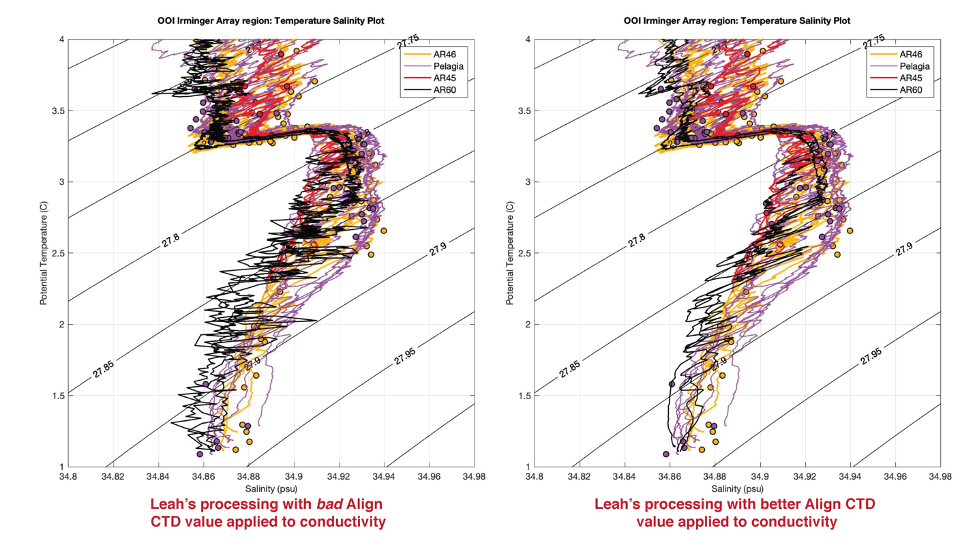
For now, I’m happy to report that the data look physically consistent! For completeness, I include the core CTD parameter difference plots from stations 4 through 11 (CTDs completed near the array thus far). CTD difference plots are described in my previous post. All checks out from where I am sitting so far. Thanks to the CTD watch standers and shipboard technicians for working so hard and taking good care of the system while the cruise is underway!
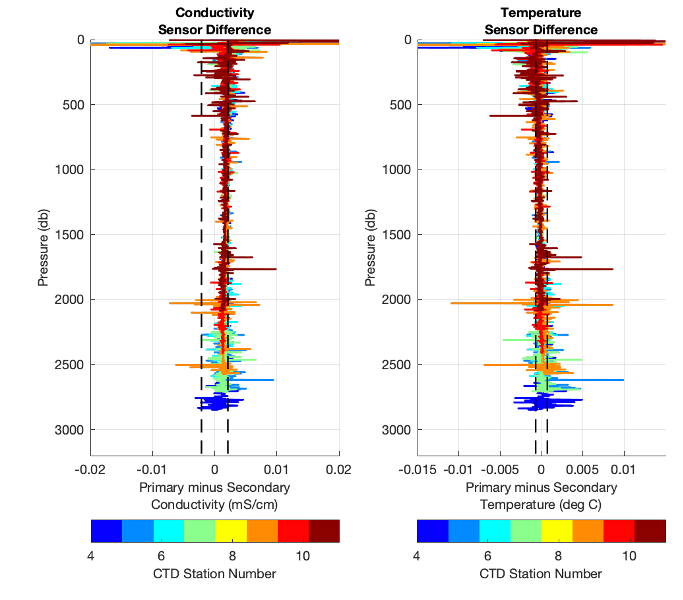
BLOGPOST #2 (August 10, 2021)
For this post I’d like to introduce some of the tools that folks can use to identify CTD issues and sensor health while at sea. Most of what I’ll be discussing here is specific to the SBE911 system that is commonly used on UNOLS vessels; however, a lot of these topics are relevant to other types of profiling CTD systems.
There are several end case users of CTD data within science. These include people who perform CTDs along a track and complete what we call a hydrographic section (useful in studying ocean currents and water masses); those who perform CTDs at the same location year after year to look for changes; people who use CTDs to calibrate instrumentation on other platforms (moorings, gliders, AUVs, etc.); and those who use the CTD to collect seawater for laboratory analysis (collected samples can be used to further analyze physical, chemical, biological, and even geological properties!). For each of these CTD uses, a core set of CTD parameters are needed.
Core CTD parameters include pressure, temperature, and conductivity. Conductivity is used together with pressure and temperature measurements to derive salinity. These three variables are needed to give users the critical information of depth and density in which water samples are collected, and support the calculation of additional variables. For example, ocean pressure, temperature, and salinity together with a voltage from an oxygen sensor are needed to derive a value for dissolved oxygen. In addition to core CTD parameters, it is very common to add dissolved oxygen, fluorescence, turbidity, and photosynthetically active radiation (PAR) sensors to a shipboard CTD unit. Each of these additional measurements have errors that must be propagated from the core CTD measurements – creating a rather complex system to navigate when trying to understand the final accuracy of a given measurement.
For each CTD data application, varying degrees of accuracy are needed from the measured CTD parameters to accomplish the scientific objective at hand… And this is where a lot of folks get into trouble! For a first example, consider someone who would like to calibrate a nitrate sensor that is deployed for a year on a mooring using water samples collected from the CTD. For a second example, consider someone who is interested in the changing dissolved oxygen content of deep Atlantic Meridional Overturning Circulation waters. In both cases, the core CTD parameters are critical. In the first example, this person needs to know the pressure and ocean density at the exact location their water samples are collected during a CTD cast so they can correctly associate analyzed water sample values with the correct position of the sensor on the mooring. However, in the second example, this person may need to use both salinity and oxygen samples to improve the accuracy and precision of CTD measurements so that their final data product will be sensitive enough to resolve small, but potentially critical, changes in the ocean.The most important take away here (CTD soapbox moment!) is that even if end users are not specifically interested in studying physical oceanographic parameters, they still need tools to verify that 1) the core CTD measurements are of high enough quality for use in their application and 2) that there are no unnecessary errors from the core measurements that are impacting their ability to address their scientific objective.
This is the first reason why I heavily encourage all CTD end users to become familiar not only with the accuracy of their particular measured parameter, but also the core CTD parameters. The second reason is that core CTD parameters are particularly useful in diagnosing early warning signs of CTD problems. Most shipboard systems install primary and secondary temperature and conductivity sensors on their CTDs, which provide an opportunity for in-situ sensor comparison. Additionally, calculated seawater density is particularly useful as it is one of the few properties we can make a strong assumption about – it should always increase with pressure. The density of seawater is determined by pressure, temperature, and salinity (conductivity), hence any time one or some of these recorded values is suspect, non-physical density “inversions” or “noise” may appear in the data record.
Below are two figures that can be very helpful in diagnosing CTD problems. In these examples, I am using the Irminger 8 (AR60-01) deep test cast, which took place late Sunday evening, August 8th. Figure 1 shows difference plots of the two sensor pairs (temperature and conductivity). Each panel includes vertical dashed lines indicating expected manufacturer agreement ranges (see sensor specification sheets datasheet-04-Jun15.pdf and datasheet-03plus-May15.pdf). The values shown are, ±(2 x 0.001 ºC) and ±(2 x 0.003 mS/cm) for temperature and conductivity sensors, respectively (note that 0.003 mS/cm is close to 0.003 psu for reasonable temperature ranges). In general, sensor differences should fall within, or very close to, this range when calibrated by the manufacturer within the past year. The rule can be relaxed in the upper water column, however, differences between sensors deeper than approximately 500 m that consistently fall outside of this range indicate problematic sensor drift or contamination. Figure 2 shows the calculated seawater density profile using the primary sensors. Consistent density inversions larger than ~0.1 kg/m3 also indicate problematic sensor drift or contamination. When creating such figures, always look at the downcast and upcast (skipped here for the sake of brevity). The upcast will look a bit worse than the downcast (I encourage you to read about why), but those data are extremely important to anyone collecting water samples!
Figure 1

Figure 2

So, what can these plots tell us about the CTD system implemented on the Irminger 8 cruise so far? Figure 1 demonstrates an overall acceptable level of agreement between the sensor pairs. The particular sensors in use right now have calibrations older than one year, so this level of agreement is actually quite good. Figure 2 is also rather promising in showing a density profile that is continuously increasing. If you’re being picky (like me), you may notice that there are some small density inversions between roughly 200-500 m. After taking a closer look, I noted that the salinity profile indicates that there are some rather impressive salinity intrusions evident in the upper 500 meters (I encourage you to download data from cast 2 and verify!). This is normal for the Labrador Sea region where the cast took place (lots of melting ice nearby) and will naturally create a bit more “noise” in these plots. So, I’m not very concerned by this.
Now what do these plots look like when there’s a problem? There unfortunately isn’t one simple answer for this (I’ve been doing this for over ten years and am still learning subtle ways CTDs show problems!), but I’ll share two examples of when something was clearly wrong. The first example is from the Irminger 7 cruise (AR35-05). Figure 3 and Figure 4 show our two plots for stations 1-13 of the Irminger 7 cruise. Figure 3 shows a suspiciously large offset (well outside of the general threshold we expect in the conductivity differences) and incredibly noisy differences in both conductivity and temperature. Similarly, Figure 5 shows consistent and large density inversions for some of these casts. Several of the casts shown in Figures 4 and 5 were so bad that there are no usable profiles as far as scientific objectives are concerned. Luckily, however, there were a few casts in the set that could be corrected with water sample data (I’ll talk more about this later). Data loss is something that does happen while at sea, and the Irminger Sea in particular is an incredibly harsh environment to work in. However, if folks are diligent in creating these plots while at sea, the hope is that we can minimize time and data loss while striving for the highest quality data possible.
Figure 3

Figure 4

For my last example, I provide a quick reference guide for how core CTD parameter issues may look on a Seabird CTD Real-Time Data Acquisition Software (Seasave) screen. The reason for this is that a lot of people don’t have time to create fancy plots while at sea, so it’s helpful to know how to approach monitoring while watching the data come in. Follow the link here to download a one-page pdf that can be displayed next to your CTD acquisition computer.
BLOG POST #1 (August 2, 2021)
[caption id="attachment_21736" align="aligncenter" width="2560"]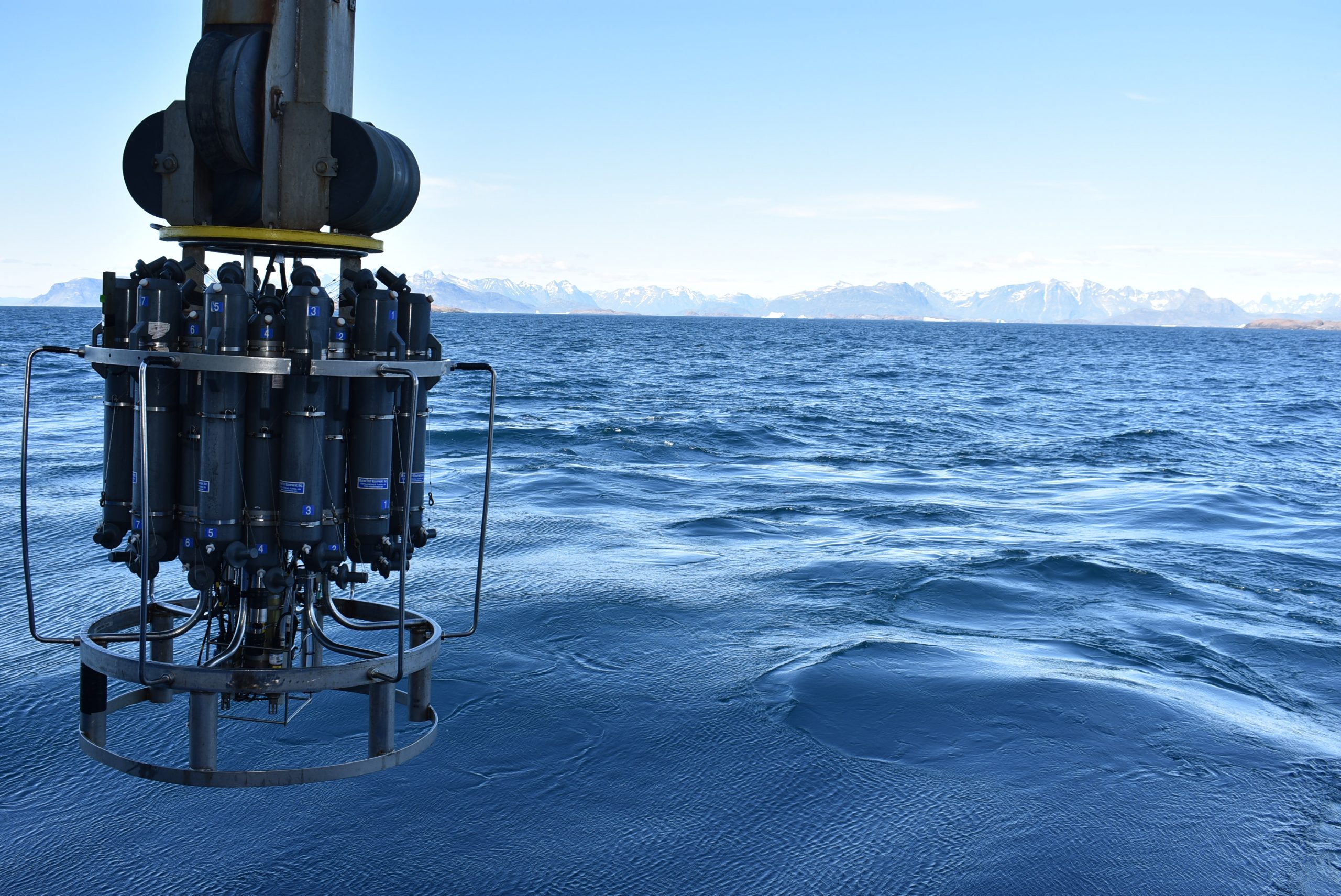 A CTD is performed near the coast of Greenland during one of the OSNAP 2020 cruises on R/V Armstrong. Photo: Isabela Le Bras©WHOI[/caption]
A CTD is performed near the coast of Greenland during one of the OSNAP 2020 cruises on R/V Armstrong. Photo: Isabela Le Bras©WHOI[/caption]
Hello folks and welcome to the Irminger 8 CTD blog! As the cruise progresses, tune in here for updates on Irminger 8 CTD data quality as well as tips on how best to approach using OOI CTD data. I plan to keep this information inclusive for folks with varying levels of experience with shipboard CTD data – from beginner to expert! If you have any questions about CTD data, feel free to send me an email (lmcraven@whoi.edu) and I’ll do my best to help. For this first post, I would like to summarize some important resources available to the community that will greatly help with CTD data acquisition and processing.
CTDs have been around for a while, which on the surface makes them a bit less interesting than many of the new exciting technologies used at sea. The fact remains that the CTD produces some of the most accurate and reliable measurements of our ocean’s physical, chemical, and biological parameters. Aside from being very useful on their own, CTD data serve as a standard by which researchers can compare and validate sensor performance from other platforms: gliders, floats, moorings, etc. Sensor comparison is particularly important for instruments that are deployed in the ocean for a long time (as is the case for OOI assets) as it is normal for sensors to drift due to environmental exposure and biological activity. As it turns out, CTD data provide a backbone for all OOI objectives.
However, just because CTDs have been performed for decades, we can’t always assume that that collection of quality data is straightforward. For example, one of the unique challenges of collecting CTD data near the OOI Irminger site and Greenland region is that there is an elevated level of biological activity throughout the year. While biological activity is exciting for many researchers, it can clog instrument plumbing, build up on sensors, and just be plain annoying to watch out for. CTDs utilized in the Irminger Sea are also subject to extreme conditions such as cold windchills and rough sea state (Cape Farewell is actually the windiest place on the ocean’s surface!), leading to the potential for accelerated sensor drift and the need to send sensors back to manufacturers for more regular servicing and calibration. As one can imagine, there are a lot of potential sources of error when simply considering the environment that OOI Irminger CTD data are collected in.
To help combat some of these potential sources of error, I’ll be picking apart CTD and bottle data cast by cast to look for evidence of CTD problems during the Irminger 8 cruise. But before we can talk about unique sources of CTD data errors, it’s helpful to remember errors that can become systematic throughout the entire data arc: from instrument care, to acquisition, to data processing, and to final data application. Improving our awareness of these issues will allow all CTD data users the opportunity for more meaningful data interpretation. So before I move forward, I thought it would be important to share some of my favorite resources available on community-recommended CTD practices. I encourage folks to comb through these resources and find what might be most appropriate for your respective research objectives.
Recommended CTD resources are provided here.
Read More
CGSN Infrastructure and Operations Webinar
In case you missed it, here’s another chance to join the leaders of the Coastal and Global Scale Node (CGSN) team to hear them describe the infrastructure making up the CGSN arrays, the current status of deployment, and how researchers and educators can get involved with the OOI.
[embed]https://vimeo.com/607455613[/embed] Read More
Endurance 15 Happening in Sept
On September 8th, a science team of ten and three students from Oregon State University will depart the dock at Newport, Oregon, aboard the R/V Thomas Thompson for the 15th turn of the Coastal Endurance Array. The team will recover and deploy seven moorings. Four of the moorings are located on the Washington Shelf, with the remaining three on the Oregon Shelf. It’s a busy expedition. The team also will be recovering four and deploying three Coastal Surface Profilers and recovering three gliders that are low on power. When not turning the arrays, they will be taking CTD (connectivity, temperature, and depth) casts to verify and calibrate instrumentation. Because of the quantity of the equipment to be recovered and deployed, the cruise will consist of three legs.
“As we head to sea for the fifteenth time to turn this array, it’s remarkable to consider that the Endurance Array has been generating data for researchers, teachers, and others interested in the ocean, every day, 24/7 for the past seven years, said Jonathan Fram, who is the chief scientist for Endurance 15. “Our data has helped identify everything from warm blobs to low-oxygen events, to even the impact of forest fire smoke miles from shore.”
[media-caption path=”https://oceanobservatories.org/wp-content/uploads/2021/09/Screen-Shot-2021-09-03-at-3.17.24-PM.png” link=”#”]Members of the Coastal Endurance Array 15 team prepare moorings for moving to pier for loading onto the R/V Thomas Thompson. Credit: Jon Fram, OSU.[/media-caption]To help advance science, the Endurance 15 team also will be sampling for researchers with instruments on the Endurance Array moorings. The team will collect fouling communities growing on panels attached to its deployed buoys for researcher Linsey Haram of the Smithsonian Institution. They will also collect settling organisms on devices attached to two multi-function nodes for Oklahoma State researcher Ashley Burkett.
The team also will be testing potential instrument replacements and new sampling strategies for coastal moorings. Additionally, they will be assessing technical improvements to the moorings and instrumentation that range from a new solar panel frame design to prevent sea lions from unplugging the panels to improvements to cameras deployed on the moorings with off-the-shelf replacement parts to ensure longevity and resilience.
Check back here often during September as the Endurance Array 15 team shares reports and photographs of their expedition.
Read MoreRCA Cruise Turns Toward Recovery Operation
The Regional Cabled Array team successfully completed its annual operations and maintenance cruise and was supposed to be back in port September 2. The R/V Thompson and ROV Jason, however, were called on to assist the E/V Nautilus recover its two ROVs Hercules and Argus. Don’t miss the remarkable opportunity to watch this operation live http://nautiluslive.org/.
The two ROVs were successfully recovered. After a 26-hour diversion, the Thompson headed back to port for the official end of the RCA expedition.
Read MoreVideo of OOI Data Users Town Hall
On 24 August, OOI Data Lead Jeff Glatstein, Axiom Data Science Designer Brian Stone, and Axiom Data Science Coder Luke Campbell gave a preview of upcoming additions to Data Explorer that will help users access glider data. The presenters sought input from OOI’s user community to improve the platform to ensure it meets data users’ needs when it goes live in September 2021. You can see the demonstration of the upcoming Data Explorer changes in the video below and hear suggestions from OOI’s data users community.
[embed]https://vimeo.com/592362218[/embed]
Read More
Kathleen Gonzalez: Student Ambassador for VISIONS’21 Expedition
The first time Katie Gonzalez went to sea was as a student participant on the 2017 Ocean Observatories Initiative (OOI) annual operations and maintenance Regional Cabled Array (RCA) VISIONS’17 cruise. From that experience, she knew that whatever she did in the future needed to involve the oceans.
Katie recently graduated as a first-generation college student from the University of Washington (UW) with her bachelor’s degree in biological oceanography. But despite her young age, she has amassed a vast amount of sea-going experience. This year marks her fifth time joining the RCA VISIONS cruises, and the third time she has participated in all legs of the expedition.
Last year, when UW limited the number of people who could go on the cruise due to COVID restrictions, Katie was one of only two student participants aboard. As restrictions eased this year, she was excited to welcome back her peers as their student ambassador, using her extensive knowledge and experience to mentor the first-time students on how to use the equipment and interact with the scientists and crew aboard the ship. “Compared to the other students, I’ve had so much more prior experience, and that’s definitely been helpful,” she says. “I’m excited to have some new responsibilities.”
This year, she is also a key member of the science party, mentoring the 19 undergraduate VISIONS’21 students on the intense logging operations and acquisition of 4K and digital still imagery in the remotely operated vehicle Jason control van.
[media-caption path="https://oceanobservatories.org/wp-content/uploads/2021/08/Eve_Katie_Newport_20180701_153908_L2_startSmall.jpg" link="#"]Katie Gonzalez (left) poses with Eve Hudson (right) on the VISIONS ’18 cruise. Katie is currently acting as student ambassador on the VISIONS ’21 cruise. Credit: University of Washington, V18.[/media-caption]Katie first became interested in oceanography when she was attending high school in Clallam Bay, Washington. During one very memorable science class, Dr. Deb Kelley, an oceanography professor at UW and PI/Director for the RCA, came to show her class how to make environmental sensors, which they deployed in the school’s garden.
This experience inspired Katie to pursue a college degree in oceanography, and she decided to apply to UW to work with Professor Kelley. Since decisions for UW’s Seattle campus had already closed, she decided to attend the UW at Bothell and transferred to the Seattle campus the following year. In the meantime, she still wanted to work with Professor Kelley, so she commuted 45 minutes on public transportation to the main campus to work on OOI RCA projects in Professor Kelley’s lab.
Katie’s extensive experience working with OOI and doing research at sea motivated her to write her senior thesis using RCA data.
“I knew that whatever I was doing for my thesis, I wanted to use data from the RCA,” she recounts. As a biological oceanography student, she was most interested in biological happenings in the ocean to which she felt a personal bond. That’s when she heard about the RCA hydrophone data. The RCA hydrophones are used to listen for seismic events along the Juan de Fuca Ridge and Cascadia Margin, but they are also constantly bombarded with marine mammal calls, including whale vocalizations. “That was the connection I was looking for,” explains Katie. She decided to investigate fin whale calls at two different sites along the RCA by analyzing the timing and frequency of their calls. She chose to look at vocalizations from the Slope Base (~125 km from the Oregon coast) and the Axial Base (~475 km from the Oregon coast) sites because whales tend to congregate in areas of high bathymetric relief.
Fin whales are considered a vulnerable species because they have been heavily impacted by human activity.
“Looking into what the whales are doing, where they’re going, and how they’re interacting with their environment will be helpful in guiding the protection of these species,” says Katie.
Working with Dr. William Wilcock, a UW Oceanography professor and a seismologist who has been studying whale calls in the Northeast Pacific for several years, she fed five years of RCA hydrophone data into an algorithm that helped filter out data that matched the frequencies of fin whale calls. She then visualized the data as a spectrogram, which allowed her to make comparisons for frequency correlations.
“That was the moment when everything—the oceanography, the data science, and my human emotion for biological creatures—came together,” she recalls.
The preliminary results of this research showed that the whales appeared at the Slope Base site closer to the continental shelf two to three months earlier in their calling season, before moving out to the far off shore blue water environment of Axial Base. Both sites had their largest volume of calls in January.
Katie has several hypotheses about the seasonal patterns she observed. “They could be following their prey, or coastal upwelling could be providing them with more food closer to the shelf during those months. As for why both sites have peaks in January, that’s a question for further research.”
Her thesis detailing her research and its conclusions was published in the UW FieldNotes Journal.
Now that she has graduated, Katie hopes to continue with her research on whales. For now, she is happy to carry on working in the Kelley lab and helping out on the RCA VISIONS ’21 cruise. She will be writing two guest blog posts about her experience on the VISIONS ’21 cruise. Live updates for the VISIONS ’21 cruise can be found here.
[media-caption path="https://oceanobservatories.org/wp-content/uploads/2021/08/CTD_Katie_MIkeV-scaled.jpg" link="#"]Katie Gonzalez (right) and Mike Vardaro (left) work with the CTD rosette on the VISIONS ’18 cruise. Katie is a key member of the science party on the VISIONS ’21 cruise. Credit: University of Washington, V18.[/media-caption] Read MoreStudents Participate Virtually in Irminger Sea 8
Twelve students from Paige Teves’ fourth-grade class virtually boarded the R/V Neil Armstrong via Zoom in early August to learn what it’s like to be at sea transporting lots of ocean observing equipment in and out of the water for a month. The connection was made through John Lund, an engineer at Woods Hole Oceanographic Institution and chief scientist for the eighth turn of the OOI’s Global Irminger Sea Array. John’s daughter, Annika, is a student in Ms. Teve’s class in the Summer Adventures in Learning (SAIL) program, a summer education program in Marion, MA for students in pre-kindergarten through 8th grade.
The Irminger Sea Array 8 team took turns holding up the “Zoom phone” to share their experiences with the students and the implications of their work in helping better understand the ocean and its role in the changing climate. The Irminger sea Array 8 team took the opportunity to showcase the different roles and genders involved in the work onboard the ship to demonstrate to the students the many possibilities in STEM careers.
Chief Scientist John Lund initiated the visit by explaining what the project was about (gathering real-time ocean data in one of the most important and difficult to sample regions in the Atlantic Ocean ), where they were (in the Atlantic off the Southeast coast of Greenland) and what they were doing (recovering and deploying ocean observing equipment).
[feature][caption id="attachment_21913" align="aligncenter" width="487"]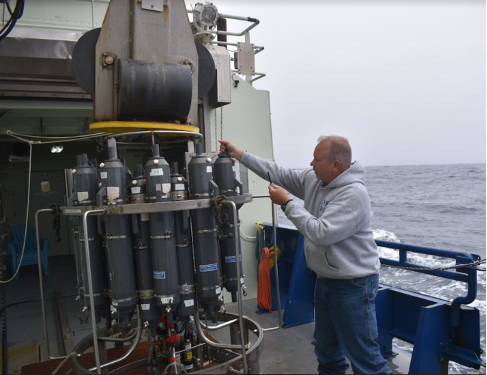 Chief Scientist John Lund showed off the CTD rosette, which is used to measure the temperature, conductivity, and density of seawater. He had the bonus of seeing his daughter via the Zoom call, who was a participant in the SAIL program. Credit: ©WHOI, Andrew Reed.[/caption]
Chief Scientist John Lund showed off the CTD rosette, which is used to measure the temperature, conductivity, and density of seawater. He had the bonus of seeing his daughter via the Zoom call, who was a participant in the SAIL program. Credit: ©WHOI, Andrew Reed.[/caption]
[/feature]
Engineer and Instrumentation Lead Jennifer Batryn explained her role working with the instruments. She took them on a virtual tour of one of the surface moorings, pointing out the different instruments and explaining what the measure.
[feature][caption id="attachment_21914" align="aligncenter" width="610"]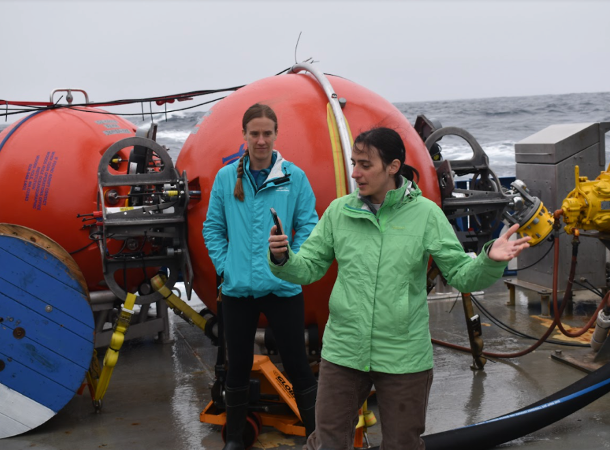 Engineers Jennifer Batryn (in back) and Stephanie Petillo (on phone) took turns talking about the equipment they are responsible for aboard the R/V Neil Armstrong. Credit: ©WHOI, Andrew Reed.[/caption]
Engineers Jennifer Batryn (in back) and Stephanie Petillo (on phone) took turns talking about the equipment they are responsible for aboard the R/V Neil Armstrong. Credit: ©WHOI, Andrew Reed.[/caption]
[/feature]
Senior Oceanographic Engineer, Software Architect & Manager, Oceanographic Roboticist and Technologist Stephanie Petillo explained her role as software lead and how the data are collected and relayed back to shore for the engineers and scientists, both to operate the array and to study the data.
[feature][caption id="attachment_21912" align="aligncenter" width="566"]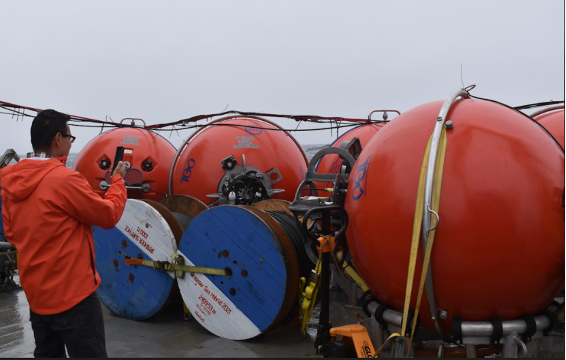 Engineer Dan Bogorff showed the 4th grade SAIL program students the floats that comprise part of OOI’s subsurface moorings. Credit: ©WHOI, Andrew Reed.[/caption]
Engineer Dan Bogorff showed the 4th grade SAIL program students the floats that comprise part of OOI’s subsurface moorings. Credit: ©WHOI, Andrew Reed.[/caption]
[/feature]
Engineer and Subsurface Mooring Lead Dan Bogorff presented the Subsurface Moorings, explained their different requirements from surface moorings. Like Batryn, he explained to the students the different instrument on these below-the-surface moorings and what kind of data they collect and report back.
The students peppered each of the presenters with great questions, demonstrating their curiosity and engagement.
Teacher Paige Teves summed up the experience, saying: “What an awesome experience we had today! It was so cool for everyone, including myself, to see everything we have learned in our summer session about climate change come together by listening to scientists and engineers share what they do.”
Added Chief Scientist Lund, “We are glad the kids enjoyed the experience and hope some of them will be inspired to pursue the fields of science and engineering.”
The SAIL program is sponsored by the Old Rochester Regional School District and Superintendency Union #55. The school district includes the towns of Marion, Marion, Mattapoisett, and Rochester in Plymouth County, Massachusetts.
Read More

